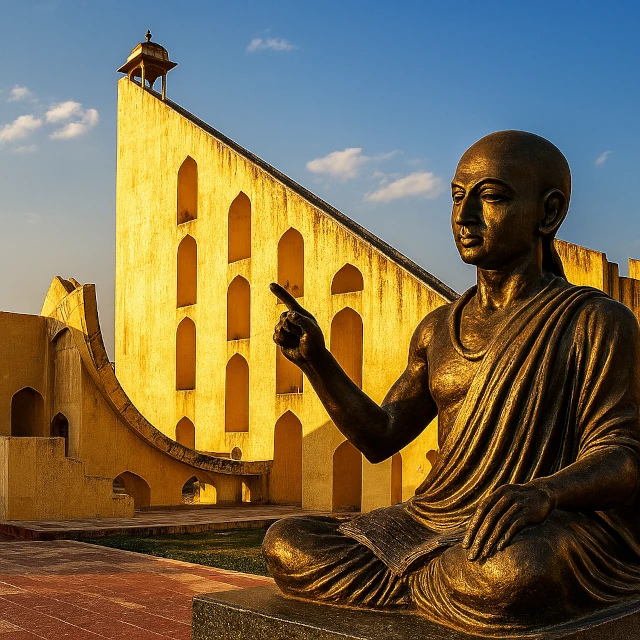
Indian astronomy has its roots in the Vedas, sacred texts composed between 1500 and 500 BCE. The Rigveda, the oldest, already contains observations of solar movement, lunar phases, and nakshatra (27 or 28 lunar constellations) used as calendar markers. These divisions of the lunar zodiac, essential to the Hindu calendar, testify to systematic sky observation from the Vedic period.
The Vedanga Jyotisha (c. 1400-1200 BCE), auxiliary texts to the Vedas, constitute the first treatises on Indian astronomy. They describe solar and lunar cycles, establish rules for determining auspicious moments for rituals (muhurta), and introduce the concept of yuga (cosmic era). The Vedic year had 360 days, divided into 12 lunar months with intercalary months to adjust the calendar to the seasons.
N.B.:
The Indian lunar zodiac (nakshatra) divides the sky into 27 or 28 segments based on the Moon's monthly path, unlike the Western solar zodiac of 12 signs. Each nakshatra corresponds to about 13°20' of celestial longitude, and the Moon passes through one nakshatra per day (≈27.3-day cycle). This system, attested in the Rigveda, allowed the calculation of lunar calendars and the determination of auspicious moments for rituals with daily precision.
From the 4th century CE, Indian astronomy underwent a mathematical revolution with the Siddhantas, scientific treatises combining observations and trigonometric calculations. This period marked the transition from ritual astronomy to precise mathematical science, integrating Greek influences and original developments.
Aryabhata (476-550 CE), in his Aryabhatiya, proposed major advances: he calculated the Earth's circumference as 39,968 km (actual value: 40,075 km), a remarkable precision. He described the Earth's rotation on its axis, explained eclipses by the Earth's shadow on the Moon (not by the demon Rahu), and developed trigonometric methods including sine tables.
Brahmagupta (598-668 CE), in the Brahmasphutasiddhanta, introduced fundamental mathematical concepts, notably the systematic use of zero as a number and the rules of negative arithmetic. He established formulas to calculate planetary positions with a precision of a few arcminutes.
N.B.:
The invention of the decimal system and the use of zero by Indian scholars (around the 5th century CE) profoundly changed the way calculations were performed. This innovation later spread to the Arab world and Europe, and today forms the basis of our numbers and calculations.
Indian astronomers developed sophisticated geometric models to predict planetary positions. They used eccentric circles (where Earth does not occupy the center of planetary motion) and modified equants (a fictitious point around which angular velocity appears uniform). Unlike the Ptolemaic system based on complex epicycles (small circles rotating on larger circles), the Indian model favored a simpler but equally precise geometric approach.
Bhāskara II (1114-1185 CE), in his Siddhanta Shiromani, reached the pinnacle of Indian mathematical astronomy. He calculated the duration of the Earth's sidereal revolution with extraordinary precision: 365.2588 days (modern value: 365.2564 days). His work on infinitesimal calculus predated that of Newton and Leibniz by several centuries.
| Name | Period | Major Contributions | Main Works |
|---|---|---|---|
| Lagadha | c. 1400-1200 BCE | Presumed author of the Vedanga Jyotisha; established lunar-solar cycles and Vedic calendar rules. | Vedanga Jyotisha |
| Aryabhata | 476 – 550 CE | Earth's rotation; calculation of Earth's circumference; rational explanation of eclipses; trigonometry (sine tables). Correction algorithms, approximations for π. | Aryabhatiya (499 CE) |
| Varahamihira | 505 – 587 CE | Compilation of astronomical and astrological knowledge; comet observations; improvement of planetary tables. | Pancasiddhantika, Brihat Samhita |
| Brahmagupta | 598 – 668 CE | Use of zero; arithmetic of negative numbers; precise calculations of planetary positions; interpolation methods. | Brahmasphutasiddhanta (628 CE) |
| Bhāskara I | c. 600 – 680 CE | Commentaries on Aryabhata's work; rational approximations of trigonometric functions. | Mahabhaskariya, Laghubhaskariya |
| Lalla | c. 720 – 790 CE | Improved eclipse calculations; observations of irregular planetary motions. | Shishyadhivriddhida Tantra |
| Bhāskara II | 1114 – 1185 CE | Record precision for the sidereal year; early infinitesimal calculus; solution of Diophantine equations. | Siddhanta Shiromani (1150 CE) |
| Madhava of Sangamagrama | c. 1340 – 1425 CE | Founder of the Kerala School; infinite series for π and trigonometric functions; differential calculus. | Works transmitted by disciples |
| Nilakantha Somayaji | 1444 – 1544 CE | Partially heliocentric planetary model (planets around the Sun, Sun around the Earth); precession of the equinoxes. | Tantrasamgraha (1500 CE) |
| Jai Singh II | 1688 – 1743 CE | Construction of the Jantar Mantar observatories; monumental stone instruments (giant sextant, meridian, dials); revised astronomical tables. | Zij-i Muhammad Shahi |
Indian astronomy illustrates a remarkable synthesis between mathematical rigor and spiritual vision. Unlike the Western rupture between science and religion, the Indian tradition maintained a constant dialogue between precise observation and metaphysical reflection.
The Indian corpus circulated westward and eastward: translations and exchanges with the Islamic world, invention of zero and the decimal numeral system, transmission of trigonometric methods, and later, preservation of an algorithm-centered art of calculation that nourished regional astronomical practice. The Indian tradition illustrates a form of mathematical engineering applied to the sky: tables, algorithms, instruments, a technical model of applied science.
References:
– Pingree, D., Jyotiḥśāstra: Astral and Mathematical Literature, Harrassowitz (1981).
– Kak, S., The Astronomical Code of the Ṛgveda, Oklahoma State University (2000).
– Plofker, K., Mathematics in India, Princeton University Press (2009).
– Sarma, K.V., A History of the Kerala School of Hindu Astronomy, Vishveshvaranand Institute (1972).
– Sharma, V.N., Sawai Jai Singh and His Astronomy, Motilal Banarsidass (1995).